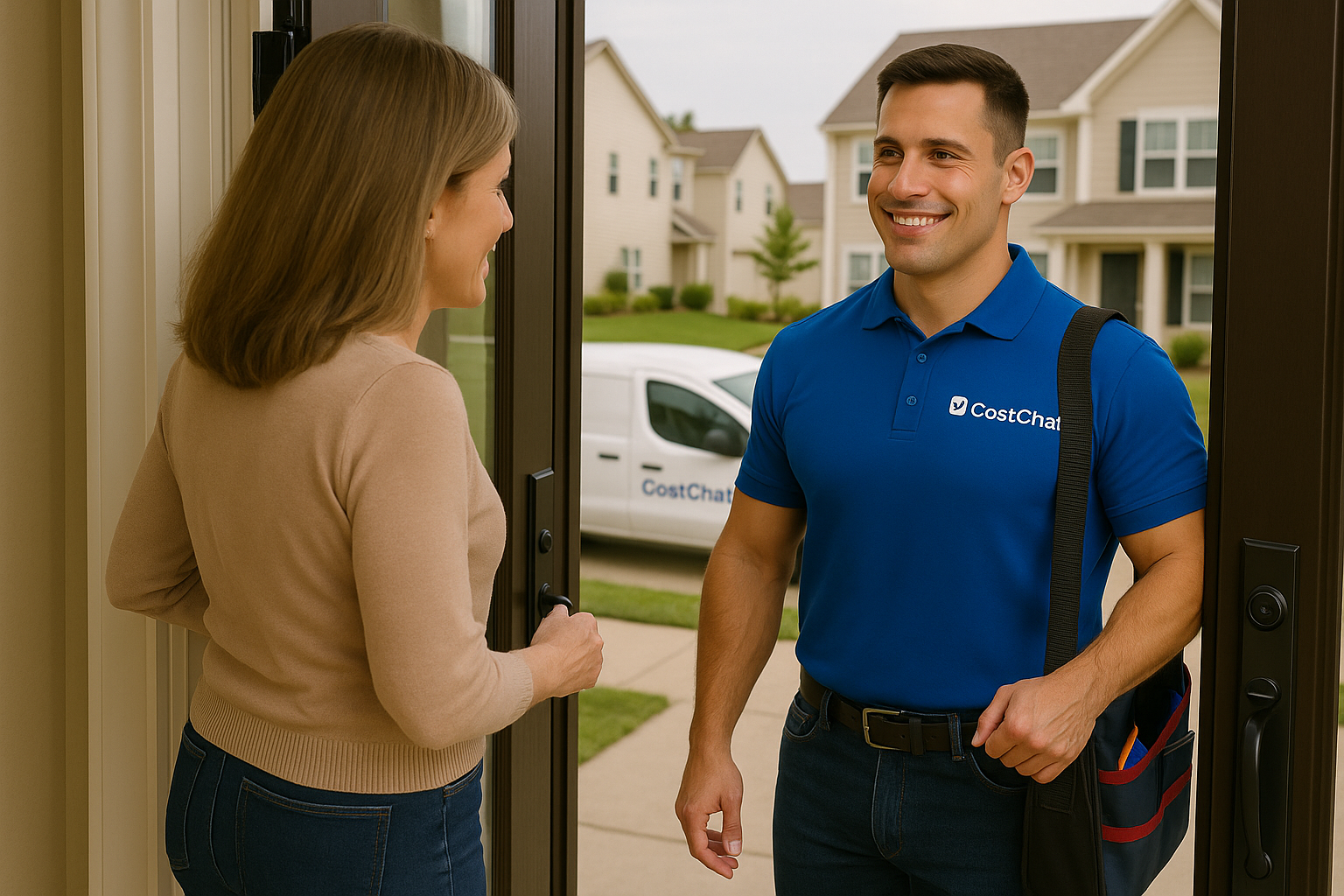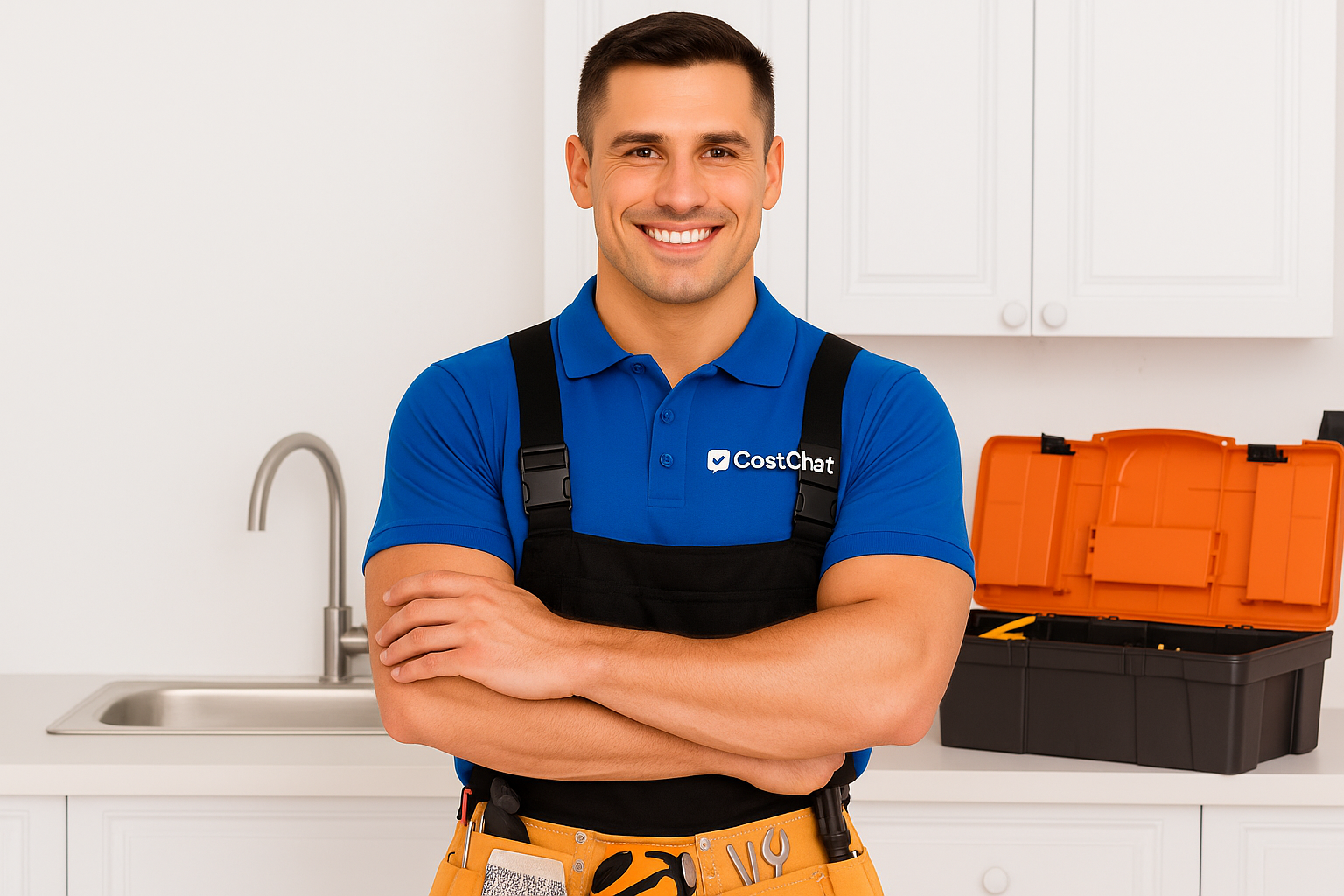
Your Go-To Burst Pipe Repair Team in San Bernardino, CA
How to Hire Top Rated Burst Pipe Repair Pros in San Bernardino, CA
Get a Free Online Estimate
Share your project details and receive a free online estimate from top-rated local pros. Not sure what it should cost? Check our Cost Guide.
Get EstimateCompare Local Quotes
View multiple free online quotes side by side. Use our Price Guide to understand labor rates, materials, and service fees before you hire.
Compare NowBook Best Top Rated Pros
Choose a licensed pro with confidence. Lock in your date after reviewing your free estimate and browsing our expert Cost Guide for peace of mind.
Book NowDid You Know?
74% ⚠️
of homeowners face surprise costs and delays — mostly from hiring unvetted pros. Don’t risk it. Hire trusted experts today.
Hire Top Rated & Verified ProsWork With Verified & Trusted Pros 🛡️
Save time, avoid costly mistakes, and experience reliable, top-quality service for every home project. Book now for priority scheduling and peace of mind.
Hire a Top Rated ProGet Instant Online Estimate of Burst Pipe Repair in
🔎 CostChat Online Cost Estimator
Describe your project and location to get an instant estimate.
Your Ultimate Guide to Burst Pipe Repair in San Bernardino, CA
Experiencing a burst pipe can be a homeowner's worst nightmare, bringing unexpected water damage, disruption, and stress. In San Bernardino, California, where a mix of historic charm and modern growth defines our community, understanding the nuances of plumbing is crucial for protecting your home. This guide is crafted specifically for San Bernardino residents to provide comprehensive, actionable advice on recognizing, responding to, and preventing burst pipe emergencies, ensuring your home remains a sanctuary.
Table of Contents
- San Bernardino's Unique Burst Pipe Repair Landscape: Why Local Expertise Matters
- The Age & Character of San Bernardino Homes: A Burst Pipe Repair-Related Time Capsule
- Burst Pipe Repair's Environmental & Utility Factors & Climate Impact on Your Plumbing
- Neighborhood Hotspots: Micro-Local Burst Pipe Repair Risks & Solutions
- Common Problems & Triggers for a Professional Burst Pipe Repair Call
- Navigating San Bernardino, CA Regulations: Permits, Code & Professional Licensing
- Maximize Your Savings: San Bernardino, CA Burst Pipe Repair Rebates & Incentives
- Choosing Your San Bernardino, CA Plumbing Solution: Options, Sizing & Smart Features
- The Cost of Burst Pipe Repair in San Bernardino, CA
- Hiring San Bernardino, CA's Top-Rated Burst Pipe Repair Professional: Your Action Plan
- Final Call to Action
- FAQs About Burst Pipe Repair in San Bernardino, CA
San Bernardino, CA's Unique Burst Pipe Repair Landscape: Why Local Expertise Matters
Understanding the specific challenges and characteristics of San Bernardino's infrastructure is key to effective burst pipe repair and prevention. Local knowledge translates into faster, more efficient solutions tailored to our city's unique environment.
The Age & Character of San Bernardino Homes: A Burst Pipe Repair-Related Time Capsule
San Bernardino's housing stock, a testament to its rich history, presents distinct plumbing considerations. Many homes, with an estimated population of 224,820 residents, were built between the mid-20th century and the 1980s. This means a significant portion of our residences rely on older, legacy plumbing systems.
- Mid-20th Century Homes (approx. 1940s-1960s): Common in neighborhoods like the Historic Downtown and parts of the University District, these homes often feature ranch-style and California bungalow designs. The primary concern here is galvanized steel piping, which is highly susceptible to corrosion and mineral buildup over time. This can lead to reduced water pressure, discolored water, and eventual pipe failure – a precursor to bursts.
- Late 20th Century Homes (approx. 1970s-1980s): While often incorporating some upgrades, homes from this era, found in areas like Harriman Park, can still have original plumbing components. You might encounter older plastic piping or continued use of older metal types that can degrade. Remodeling in these homes can also disturb aging plumbing, potentially causing leaks at joints.
The prevalence of cast iron drain lines in homes from the mid-century also poses a risk. These pipes can crack and become blocked due to corrosion and sediment accumulation, leading to slow drains and potential backups, which can exacerbate pressure issues in the water supply system.
Furthermore, homes built on concrete slabs without accessible crawl spaces, common in many San Bernardino developments, are particularly vulnerable to slab leaks. These are notoriously difficult and expensive to locate and repair once a pipe within or beneath the foundation bursts.
Burst Pipe Repair's Environmental & Utility Factors & Climate Impact on Your Plumbing
San Bernardino's unique environment and utility services play a significant role in the health of your home's plumbing system.
- Water Quality: The San Bernardino Municipal Water Department (SBMWD) supplies water primarily from the Bunker Hill Groundwater Basin. This water is known to be relatively hard, meaning it contains a higher concentration of minerals like calcium and magnesium. Over time, these minerals can build up as scale inside pipes, fixtures, and appliances. This scale buildup can restrict water flow, reduce efficiency, and, in critical cases, contribute to the weakening of pipe walls, making them more prone to bursting, especially during temperature fluctuations.
- Climate Impact: San Bernardino experiences a semi-arid climate with hot, dry summers and mild winters. While deep freezes are rare, unexpected cold snaps can still pose a risk. Pipes located in poorly insulated areas, such as unheated garages, attics, or exterior walls, are susceptible to freezing and bursting if temperatures drop suddenly.
- Soil Conditions: The region's clay soils can also be a factor. These soils expand when wet and contract when dry, which is particularly noticeable during periods of drought followed by watering. This soil movement can put stress on underground or slab-embedded plumbing lines, potentially causing them to shift, crack, or burst over time.
- Flash Flooding: While infrequent, heavy rainfall events can lead to flash flooding. These events can overwhelm the city's storm drainage systems and potentially cause backups into homes, stressing plumbing fixtures and drain lines.
Regular maintenance and understanding these local factors are crucial for preventing burst pipes in your San Bernardino home.
 Request a Quote
Request a Quote
Neighborhood Hotspots: Micro-Local Burst Pipe Repair Risks & Solutions
San Bernardino is a city of diverse neighborhoods, each with its own unique characteristics that can influence plumbing risks. Understanding these micro-local factors can help homeowners in specific areas take targeted preventative measures.
- Historic Downtown San Bernardino: Many homes here feature original infrastructure from the early to mid-20th century. Expect older pipe materials like galvanized steel and potential issues with aging sewer lines. Solution: Consider proactive whole-house repiping if your home still has original galvanized pipes. Regular drain cleaning is also essential for cast iron sewer lines.
- Arrowhead & Kendall Hills: Properties in these hillside communities might experience issues related to water pressure fluctuations due to elevation changes. Older homes may also have underground pipes affected by soil movement and shifting. Solution: Install pressure-reducing valves if high pressure is an issue. Inspect outdoor pipes regularly for signs of stress from ground movement.
- Verdemont & Del Rosa: These areas, with a mix of housing ages, can experience challenges related to both older infrastructure and potential soil expansion/contraction due to varied soil types. Solution: Be vigilant about signs of leaks, especially after significant dry spells or heavy rains. For homes on slabs, regular plumbing inspections can help catch minor issues before they become major bursts.
- Shandin Hills & San Gorgonio: Homes in these neighborhoods, potentially built during different development phases, might have a mix of plumbing materials. Older sections could mirror the concerns of downtown, while newer sections may have fewer legacy issues but still require routine checks. Solution: Understand the age and material of your plumbing. If you're unsure, a professional inspection can identify potential weak points.
No matter your neighborhood, proactive maintenance and awareness are your best defenses against burst pipes.
Common Problems & Triggers for a Professional Burst Pipe Repair Call
Recognizing the warning signs of a compromised plumbing system is crucial for preventing a full-blown burst pipe emergency. In San Bernardino, these issues are often amplified by the age of our housing stock and local environmental factors.
WARNING SIGNS: Keep an eye out for these indicators that your plumbing may be at risk:
- Reduced Water Pressure: Often caused by corrosion and mineral buildup inside pipes, common with galvanized steel pipes prevalent in older San Bernardino homes. This buildup narrows the pipe's interior diameter, restricting flow and increasing internal pressure on weak spots.
- Discolored or Rusty Water: A clear sign of corrosion within the pipes, particularly in galvanized or older copper systems. This can indicate the pipe walls are deteriorating and might be close to failure.
- Leaky Faucets or Dripping Pipes: While seemingly minor, persistent leaks can indicate failing seals or joints that, under fluctuating pressure or temperature changes, could lead to a larger rupture.
- Gurgling Sounds or Slow Drains: For drain lines, especially older cast iron ones, this points to blockages or cracks. While not directly a water supply issue, it can indicate the overall health of your plumbing system and, in extreme cases, lead to backups that affect pressure.
- Unexplained Wet Spots or Mold Growth: These are often the first visible signs of a hidden leak, potentially within walls or under the foundation (slab leaks). Early detection is key to minimizing water damage and repair costs.
- Sudden Temperature Fluctuations in Showers: This can be a sign of a failing water heater, but also sometimes indicates a disruption in the water supply lines that could precede a burst.
For plumbing systems, especially those found in homes built between the mid-20th century and the 1980s, typical lifespans for copper pipes can be 50-100 years, PEX piping 40-50 years, and older materials like galvanized steel much less, often failing after 20-40 years due to corrosion. Ignoring these warning signs significantly increases the risk of a costly burst pipe event.
Understanding these signs aligns with the critical information found in the CostChat Warning Signs Guide. If you encounter any of these issues, it’s time to consider professional help.
 Request a Quote
Request a Quote
If you suspect a plumbing emergency, remember to check What to Do in an Emergency for immediate steps.
Navigating San Bernardino, CA Regulations: Permits, Code & Professional Licensing
Ensuring your burst pipe repair or replacement work is compliant with local regulations protects your home's value and ensures safety. In San Bernardino, this means understanding the role of the City Building & Safety Department and the California Contractors State License Board (CSLB).
- Permitting Process: For significant plumbing work, including repiping or major repairs resulting from a burst pipe, permits are typically required. The City of San Bernardino's Building & Safety Department oversees this process. You can find applications and relevant information on their website: City of San Bernardino Building & Safety.
- Governing Code: San Bernardino adheres to the California Plumbing Code (CPC). This code is based on the International Plumbing Code but includes state-specific amendments designed to address California's unique seismic activity, climate, and environmental considerations. Following the CPC ensures that all work is up to current safety and performance standards.
- Required Inspections: Depending on the scope of work, inspections may be required at various stages of a plumbing project. These can include rough plumbing inspections (before walls are closed up) and final inspections. Your permit from the Building & Safety Department will detail the specific inspections needed for your project.
- DIY vs. Professional Installation: While minor repairs might seem like DIY projects, complex tasks like repiping after a burst or working with main lines are best left to licensed professionals. Incorrect installation can lead to further leaks, code violations, and even safety hazards. For guidance on when DIY might be appropriate, consult the CostChat When To Consider DIY Guide.
- Contractor Licensing: All plumbing contractors in California must be licensed by the California Contractors State License Board (CSLB). You can verify a contractor's license status and check for any disciplinary actions on the CSLB website: CSLB License Lookup. Always ask for the contractor's license number and verify it yourself. Ensure they also carry proper insurance, such as general liability and workers' compensation.
Adhering to these regulations ensures your repairs are done correctly and safely.
Maximize Your Savings: San Bernardino, CA Burst Pipe Repair Rebates & Incentives
Investing in your home's plumbing, especially after a burst pipe incident, can be more affordable thanks to various rebate and incentive programs available to San Bernardino residents. These programs aim to encourage water conservation and the adoption of efficient technologies.
- SoCal Water$mart Program: This popular program often offers rebates for installing water-efficient fixtures, such as low-flow toilets and showerheads. While not directly for pipe repair, upgrading fixtures can reduce overall water system load.
- Water Heater Rebates: If your burst pipe issue also affected your water heater, look for potential rebates on energy-efficient models. These can offer significant savings on both purchase price and future energy bills.
- Leak Detection Systems: Some programs may offer incentives for installing smart leak detection systems. These systems can alert you to small leaks early, potentially preventing a major burst.
- Utility Programs: Your water provider, the San Bernardino Municipal Water Department (SBMWD), may have specific conservation programs or partner with other organizations for rebates. It's always worth checking their website: SBMWD.
- Bonus Tip: Strategic timing can maximize savings. Consider bundling plumbing upgrades with other home improvement projects to potentially leverage contractor discounts or take advantage of year-end rebate periods. Always check the CostChat Saving Tips Guide for more ways to manage costs.
It's essential to verify the current availability and specifics of these programs directly with the offering organizations, as rebate amounts and qualifications can change.
 Request a Quote
Request a Quote
Choosing Your San Bernardino, CA Plumbing Solution: Options, Sizing & Smart Features
When dealing with burst pipes or planning preventative upgrades in San Bernardino, selecting the right materials and system components is vital for long-term reliability and efficiency.
- Pipe Materials:
- Copper: A durable and traditional choice, copper is resistant to corrosion but can be more expensive and susceptible to freezing in extreme cold. It's a good option for many San Bernardino homes, especially for visible pipe runs.
- PEX (Cross-linked Polyethylene): More flexible than copper, PEX is easier to install, less prone to bursting from freezing (due to its flexibility), and generally more cost-effective. It's a popular choice for new installations and repiping projects.
- CPVC (Chlorinated Polyvinyl Chloride): Suitable for hot and cold water distribution, CPVC is also cost-effective and corrosion-resistant. However, its use may be restricted in some areas or specific applications, and it can become brittle with UV exposure.
- Sizing Your System: The correct pipe diameter depends on the fixture count and anticipated water usage in your San Bernardino home. Undersized pipes can lead to low pressure, while oversized pipes can be unnecessarily expensive. A professional can assess your home's needs to ensure proper sizing, especially important when replacing sections affected by a burst.
- Key San Bernardino Considerations:
- Hard Water Resistance: Given the mineral content of San Bernardino's water, choosing pipe materials and fixtures that are less prone to scale buildup is advantageous.
- Durability Against Soil Movement: For underground or slab pipes, flexible materials like PEX can better withstand minor soil shifts compared to rigid metal pipes.
- Freeze Resistance: While San Bernardino's winters are mild, properly insulating all pipes, especially those near exterior walls or in unheated spaces, remains a crucial step in preventing freeze bursts.
- Smart Features: Consider plumbing innovations like smart leak detectors that can automatically shut off your water supply if a leak is detected, potentially mitigating severe damage from a burst pipe.
Consulting with a qualified local plumber will ensure you choose the best materials and solutions for your specific needs and San Bernardino home.
The Cost of Burst Pipe Repair in San Bernardino, CA
The cost of burst pipe repair in San Bernardino, CA, can vary significantly based on several factors. Understanding these can help you budget and prepare.
- Emergency Call-Out Fees: Expect to pay a premium for emergency services, especially during off-hours or weekends. These fees can range from $150 to $300 or more.
- Labor Costs: Plumbers typically charge by the hour. In San Bernardino, rates can range from $85 to $175 per hour, depending on the plumber's experience, the company's overhead, and the complexity of the job.
- Pipe Material and Length: The cost of materials is a major component.
- Copper: Can cost $3 to $7 per linear foot for materials.
- PEX: Generally more affordable, costing $1 to $3 per linear foot for materials.
- Galvanized Steel (if used for repairs): Can range from $4 to $8 per linear foot, often higher than copper due to less common usage.
- Complexity of the Repair:
- Simple Leaks/Joint Repairs: $200 - $500
- Section Replacement (e.g., 5-10 feet): $400 - $1,000
- Whole-House Repiping (often needed after multiple bursts or for old galvanized systems): $4,000 - $10,000+, depending on home size and materials.
- Slab Leaks: These are particularly costly due to the invasive nature of locating and repairing pipes within or beneath the concrete foundation. Costs can range from $1,500 to $5,000 or more.
- Location within San Bernardino: While not a major factor, accessibility to certain neighborhoods or properties requiring extensive travel might subtly influence pricing.
- Water Damage Restoration: If a burst pipe has caused significant water damage, you'll need to factor in costs for drying, mold remediation, and repairs to drywall, flooring, and ceilings, which can add thousands to the overall expense.
Estimate Breakdown Example (for a typical pipe section replacement):
- Emergency Fee: $200
- Labor (3 hours @ $120/hr): $360
- Materials (e.g., 10 ft PEX + fittings): $70
- Total Estimated Cost: $630
These are estimates, and it's always recommended to obtain multiple detailed quotes from licensed professionals before proceeding.
 Request a Quote
Request a Quote
Hiring San Bernardino, CA's Top-Rated Burst Pipe Repair Professional: Your Action Plan
Choosing the right professional is critical for a successful and lasting burst pipe repair. In San Bernardino, a combination of local knowledge and proven expertise ensures the job is done right.
- Verify Licensing and Insurance: Always confirm that the plumber is licensed by the CSLB (California Contractors State License Board) and carries adequate general liability and workers' compensation insurance. This protects you from liability and ensures they meet state standards.
- Ask Hyper-Local Questions: Tailor your questions to San Bernardino's specific environment:
- "Given San Bernardino's hard water, what pipe materials do you recommend for longevity and minimal scale buildup?"
- "Have you dealt with slab leaks common in our area, and what detection methods do you use?"
- "How do you approach pipe replacement in homes built in the 1950s or 60s, common in areas like the Historic Downtown?"
- "Are you familiar with the permitting process with the City of San Bernardino Building & Safety Department for this type of repair?"
- Check Local Reviews: Look for reviews specifically mentioning burst pipe repairs or services in San Bernardino. Platforms like Google Reviews, Yelp, or Angie's List can provide valuable insights into a company's reliability and customer satisfaction.
- Get Multiple Detailed Quotes: Obtain written estimates from at least three different reputable plumbers. Ensure quotes clearly detail the scope of work, materials used, labor costs, and any potential additional charges. Beware of quotes that seem too good to be true.
- Insist on a Written Contract: A comprehensive contract should outline everything: the exact work to be performed, materials, timeline, warranty information, total cost, and payment schedule.
- Mistakes to Avoid: Be aware of common pitfalls. For instance, don't hire someone who can't provide proof of license and insurance, or who pressures you into an immediate decision without a written estimate. Learn more by consulting the CostChat Mistakes to Avoid Guide.
By following these steps, you can confidently select a qualified professional to handle your burst pipe repair needs in San Bernardino.
Neighborhoods We Serve in San Bernardino, CA
️ Top Neighborhoods:
- Arrowhead
- Carousel
- Del Rosa
- Downtown San Bernardino
- Kendall Hills
- San Gorgonio
- Shandin Hills <li style="margin-bottom:8px
